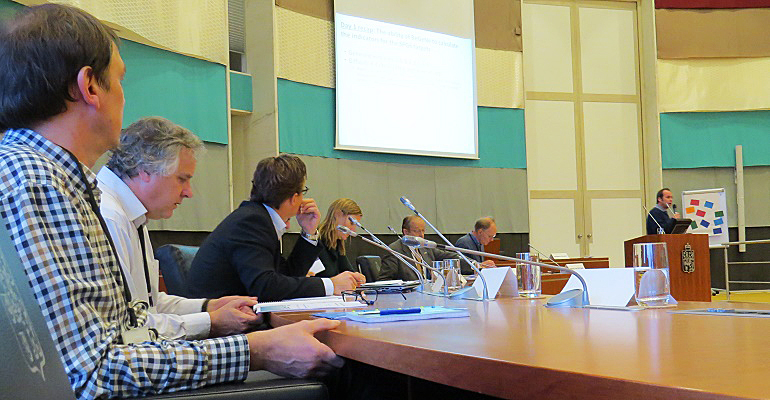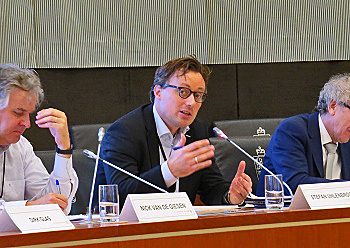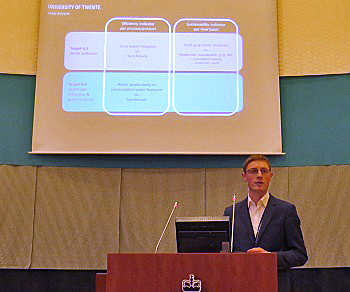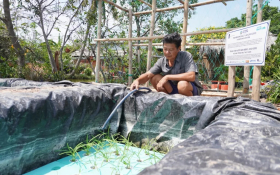Little time left to make indicators for global water goals smarter
 “How can the proposed indicators for the global water goals help to do the real thing and bring about measures that enable us to meet the global challenges?” This question was posed by professor Stefan Uhlenbrook of Unesco-WWAP at a special workshop on the monitoring of the sustainable development goal (SDG) on water.
“How can the proposed indicators for the global water goals help to do the real thing and bring about measures that enable us to meet the global challenges?” This question was posed by professor Stefan Uhlenbrook of Unesco-WWAP at a special workshop on the monitoring of the sustainable development goal (SDG) on water.
Recently 11 indicators have been proposed to monitor the sub goals of SDG nr.6 on water and in March 2016 they will be formalised by the United Nations.
Uhlenbrook is afraid that voluminous reports will be published on the individual targets with the only purpose to see how many countries have already met the global water goals.
During the workshop he plead for more meaningful indicators and to aggregate the collected data in a synthesize report that links all other water-related indicators.
The workshop had been organised by the national commissions of Unesco-IHP in Germany, the Netherlands and Belgium.
 UN coordinator Stefan Uhlenbrook suggested to make the indicators for the global water goals more meaningful.
UN coordinator Stefan Uhlenbrook suggested to make the indicators for the global water goals more meaningful.
Further discussion on two water indicators
As coordinator of the UN World Water Assessment programme Stefan Uhlenbrook is involved in the formulation of the new set of indicators for the global water goals.
A special UN working group has commented the proposed water indicators. The group advised two indicators to be discussed further. This concerns sub goal 6.4 on efficient water use, and sub goal 6.5 on implementing integrated water resource management.
Counterproductive targets
Uhlenbrook’s plea is motivated by the fact that certain targets can be contra productive. “More food means more water use by agriculture, so there is less for other users who may have been used the water more efficient”, he clarified. “What is important in one country, is not in the other. Take for instance the preservation of wetlands in Rwanda. This is a big issue in this country, but not so in countries that have no wetlands.”
He thinks it is important that countries do the reporting. “This gives an ownership to the whole monitoring system. But somehow we also need to incorporate the local importance of the global data.”
 Joep Schyns of University of Twente, showed how satellite data can already be used for worldwide monitoring of polluted surface water, water-use efficiency and water scarcity.
Joep Schyns of University of Twente, showed how satellite data can already be used for worldwide monitoring of polluted surface water, water-use efficiency and water scarcity.
Set of 8 indicators
In September the member states of the United Nations adopted 17 sustainable development goals for 2030. One goal, SDG nr.6, addresses all water issues with 8 sub goals. To monitor these sub goals, a set of 11 indicators has been suggested.
In Maastricht experts from Belgium, Germany and the Netherlands met to discuss these indicators and make recommendations for improvement.
The participants agreed that the sub goal 6.1 on universal access to safe drinking water services and sub goal 6.2 on universal access to adequate sanitation, do not need much attention. These goals are already globally monitored since 2000.
Sub goals 6.3 on safe surface water was not considered to be much of an issue in the European Union where the EU Water Frame Directory already prescribes a close monitoring of the quality of surface water and groundwater. But elsewhere in the world, the monitoring of water quality is a general practise.
Three different monitoring systems
So the workshop focused on possible indicators for water quality and efficient water use.
Three different monitoring systems were debated. In countries where the water quality has to comply with certain standards, monitoring systems are mostly based on sampling. The disadvantage is that such sampling cannot easily be scaled up to a global level.
The other system is based on remote sensing. The technology is quickly evolving and many satellites are already collecting vast amounts of water-related data. Remote sensing has the potential of a global coverage. But a main disadvantage is that the data cannot easily be verified. Besides the sensor technology is still restricted a limited number of pollutants.
The third system is citizen data collection, for instance with gps-equipped mobile phones. This provides locally very relevant data, but mostly the collected data is incidental and lack time data sequences.
It was within this setting the participants tried to figure out what would be the best indicators, given the available technology and the required validation.
It was concluded that combinations can have added value to enable a meaningful monitoring of the global water goals.
More information
Netherlands National IHP-HWRP committee
secretariat
ihp.hwrp@unesco.nl
Unesco Global water assessment division
Perugia, Italy
+39 075 59 11 01
www.unesco.org/wwap



